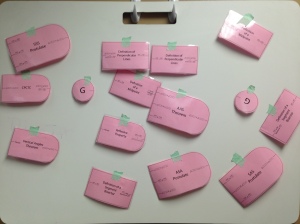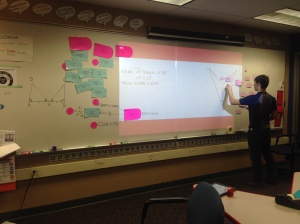I teach a single semester math class that students choose to take in an effort to avoid taking algebra 2. The class is primarily seniors whose highest level of math is geometry, and they plan to join the military or work and take a few classes at a time from our local community college.
With this in mind, I found out that our community college uses the Accuplacer as a placement test. From there, I looked at the College Boards Accuplacer Program Manual. This document lists math “skills” assessed under 3 categories: Arithmetic, Elementary Algebra & College Level Math. I put all of these skills in a spreadsheet and grouped them by content:
Based on this analysis, I should spend the semester focusing on the following topics:
- Proportional reasoning
- solving & graphing equations
- Systems of equations and inequalities
- Functions (Linear, Quadratic, Exponential)
- Solving, graphing, factoring Quadratic Equations
I am confident that the first 3 are skills my students need and I can support their understanding with great modeling tasks and real world applications (and mullets!).
I am struggling with #4 and #5 on the list above for students who are not planning on attending a four year college. This would mean spending weeks on quadratics just to prepare students for a test. I know I can find some good modeling problems, but in all honesty, in my 5 years working a professional civil engineer I did not need to factor any quadratic equations.
My gut instincts and knowledge of these students say to focus on application of exponential functions (credit, interest, population growth, etc) . I also believe that probability and statistics is missing from this list. I want to make curricular decisions based on research, data and experience, not just my “gut instincts”. I also don’t want the class to be a haphazard collection of unrelated tasks.
What would you do for the last six weeks of this class?
Update:
Based on Sandy’s comment below, I looked up our community college score requirements. Here is what I found. Why hadn’t I thought of doing this?!
They are only looking at the Elementary Algebra portion of the Accuplacer! I can filter the spreadsheet above to only show the Elematry Algebra skills and I end up with a much more manageable list. Looking back that the Accuplacer Program Manual (linked above) yeilds this information about the Elementary algebra scores:
Why are system of equations considered to be such an advanced skill?
Whelp, It looks like we will be considering some quadratics. Thank goodness for Algebra Tiles, the Math Assessment Project and Mathalicious!





